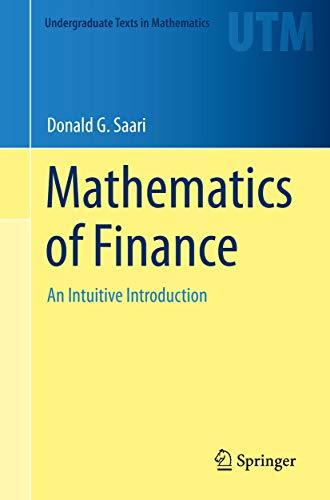Question
1)For stocks with a constant growth rate, the higher the growth rate ... (A)the higher the par value B. the lower the par value. (C
1)For stocks with a constant growth rate, the higher the growth rate ...
(A)the higher the par value
B. the lower the par value.
(C the higher the stock price.
(D the lower the stock price.
2)For an investment with monthly compounding ...
the annual percentage rate (APR) is lower than the effective annual rate (EAR).
the annual percentage rate (APR) is higher than the effective annual rate (EAR).
the annual percentage rate (APR) is equal to the effective annual rate (EAR).
the annual percentage rate (APR) can be higher or lower than the effective annual rate (EAR).
3)If you pay an additional amount on top of your fixed mortgage payment, the additional amount will reduce your outstanding balance. This in turn will ..
lower the annual percentage rate on your mortgage going forward,
(B lower your fixed payments going forward.
(C reduce the number of payments going forward.
D increase the future value of the mortgage.
4. A preferred stock trades at $110 per share and has a par value of $100. If the preferred stock pays a fixed dividend of 5% per year, the dividend paid in dollars is
more than $5 per year.
$5 per year.
I less than $5 per year.
dependent on the preferred stock price.
5 The dividend growth rate on a preferred stock is ..
zero.
based on the company's industry.
dependent on interest rates in the market.
dependent on the preferred stock price.
6) If a stock has a negative dividend growth rate ...
the constant growth model cannot be applied.
B) the constant growth model can only be applied, if the required return is also negative.
(C) the constant growth model can be applied without adjustments.
(D the constant model growth model can be applied, but the stock price will be negative.
7) Which of the following bonds has the most interest rate risk?
(A) High coupon, long maturity.
B High coupon, short maturity.
(C) Low coupon, long maturity.
(D Low coupon, short maturity.
Step by Step Solution
There are 3 Steps involved in it
Step: 1

Get Instant Access to Expert-Tailored Solutions
See step-by-step solutions with expert insights and AI powered tools for academic success
Step: 2

Step: 3

Ace Your Homework with AI
Get the answers you need in no time with our AI-driven, step-by-step assistance
Get Started


